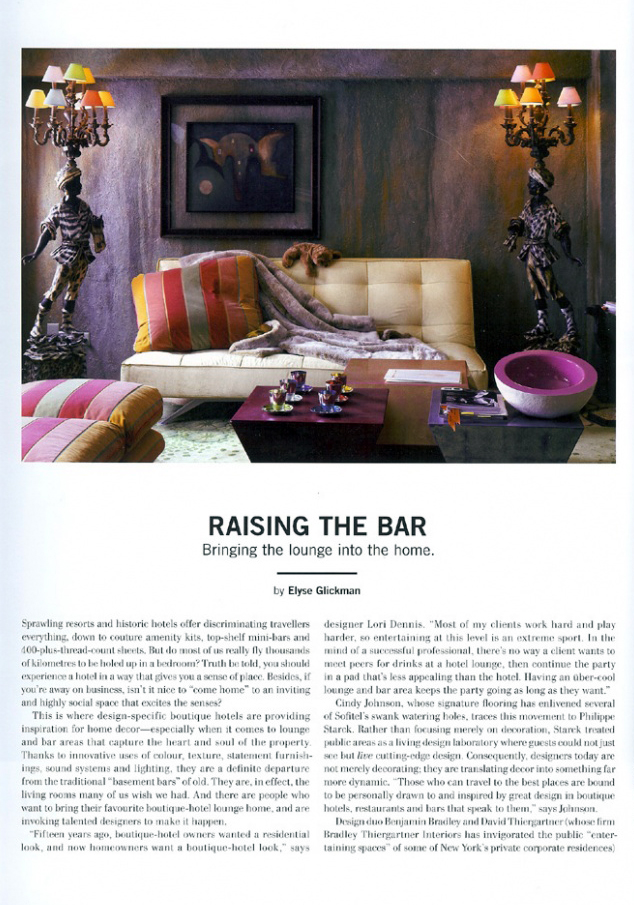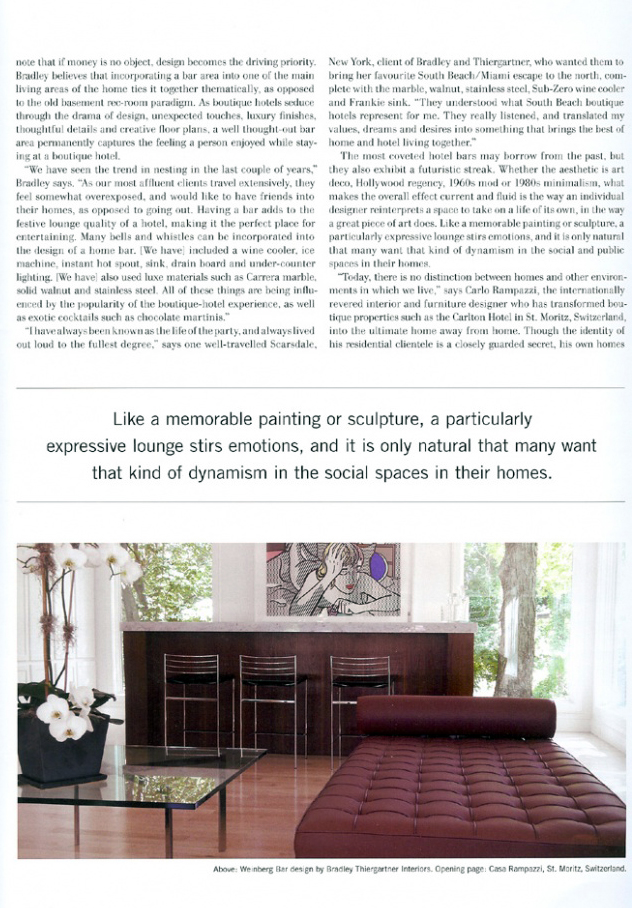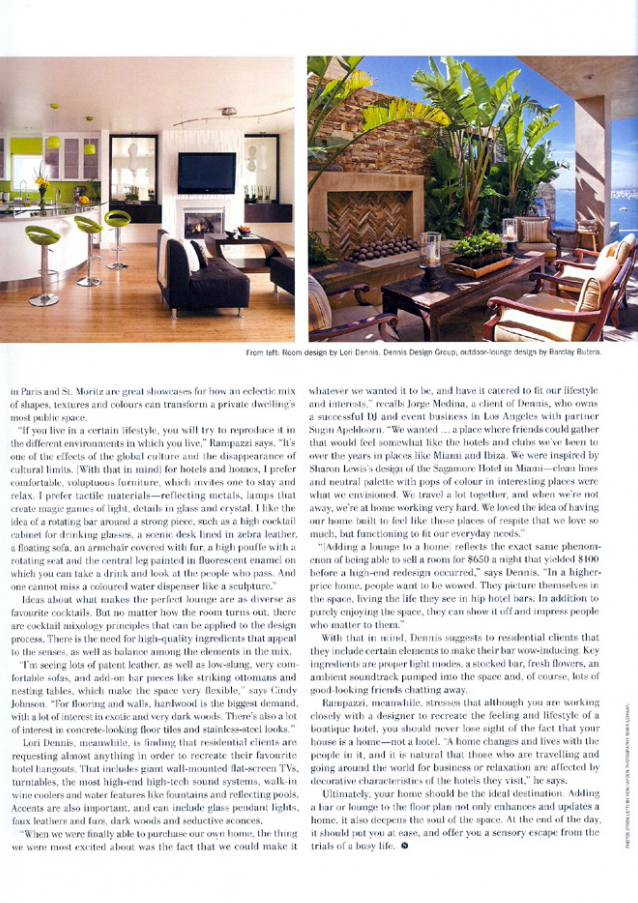RAISING THE BAR: Bringing the lounge into the home
Fall, 2008 | by Elyse Glickman | photographs by Ken Hayden & Mark Lohman
Sprawling resorts and historic hotels offer discriminating travellers everything, down to couture amenity kits, top-shelf mini-bars and 400-plus-thread-count sheets. But do most of us really fly thousands of kilometres to be holed up in a bedroom? Truth be told, you should experience a hotel in a way that gives you a sense of place. Besides, if you’re away on business, isn’t it nice to “come home” to an inviting and highly social space that excites the senses?
This is where design-specific boutique hotels are providing inspiration for home decor—especially when it comes to lounge and bar areas that capture the heart and soul of the property. Thanks to innovative uses of colour, texture, statement furnishings, sound systems and lighting, they are a definite departure from the traditional “basement bars” of old. They are, in effect, the living rooms many of us wish we had. And there are people who want to bring their favourite boutique-hotel lounge home, and are invoking talented designers to make it happen.
“Fifteen years ago, boutique-hotel owners wanted a residential look, and now homeowners want a boutique-hotel look,” says designer Lori Dennis. “Most of my clients work hard and play harder, so entertaining at this level is an extreme sport. In the mind of a successful professional, there’s no way a client wants to meet peers for drinks at a hotel lounge, then continue the party in a pad that’s less appealing than the hotel. Having an uber-cool lounge and bar area keeps the party going as long as they want.”
Cindy Johnson, whose signature flooring has enlivened several of Sofitel’s swank watering holes, traces this movement to Philippe Starck. Rather than focusing merely on decoration, Starck treated public areas as a living design laboratory where guests could not just see but live cutting-edge design. Consequently, designers today are not merely decorating; they are translating decor into something far more dynamic. “Those who can travel to the best places are bound to be personally drawn to and inspired by great design in boutique hotels, restaurants and bars that speak to them,” says Johnson.
Design duo Benjamin Bradley and David Thiergartner (whose firm Bradley Thiergartner Interiors has invigorated the public “enter-ta i spaces” of some of New York’s private corporate residences) note that if money is no object, design becomes the driving priority. Bradley believes that incorporating a bar area into one of the main living areas of the home ties it together thematically, as opposed to the old basement rec-room paradigm. As boutique hotels seduce through the drama of design, unexpected touches, luxury finishes, thoughtful details and creative floor plans, a well thought-out bar area permanently captures the feeling a person enjoyed while stay-ing at a boutique hotel.
“We have seen the trend in nesting in the last couple of years,” Bradley says. “As our most affluent clients travel extensively, they feel somewhat overexposed, and would like to have friends into their homes, as opposed to going out. Having a bar adds to the festive lounge quality of a hotel, making it the perfect place for entertaining. Many bells and whistles can be incorporated into the design of a home bar. [We have] included a wine cooler, ice machine, instant hot spout, sink, drain board and under-counter lighting. [We have] also used luxe materials such as Carrera marble, solid walnut and stainless steel. All of these things are being influenced by the popularity of the boutique-hotel experience, as well as exotic cocktails such as chocolate martinis.”
“I have always been known as the life of the party, and always lived out loud to the fullest degree,” says one well-travelled Scarsdale, New York, client of Bradley and Thiergartner, who wanted them to bring her favourite South Beach/Miami escape to the north, com-plete with the marble, walnut, stainless steel, Sub-Zero wine cooler and Frankie sink. “They understood what South Beach boutique hotels represent for me. They really listened, and translated my values, dreams and desires into something that brings the best of home and hotel living together.”
The most coveted hotel bars may borrow from the past, but they also exhibit a futuristic streak. Whether the aesthetic is art deco, Hollywood regency, 1960s mod or 1980s minimalism, what makes the overall effect current and fluid is the way an individual designer reinterprets a space to take on a life of its own, in the way a great piece of art does. Like a memorable painting or sculpture, a particularly expressive lounge stirs emotions, and it is only natural that many want that kind of dynamism in the social and public spaces in their homes.
“Today, there is no distinction between homes and other environments in which we live,” says Carlo Rampazzi, the internationally revered interior and furniture designer who has transformed bou-tique properties such as the Carlton Hotel in St. Moritz, Switzerland, into the ultimate home away from home. Though the identity of his residential clientele is a closely guarded secret, his own homes in Paris and St. Moritz are great showcases for how an eclectic mix of shapes, textures and colours can transform a private dwelling’s most public space.
“If you live in a certain lifestyle, you will try to reproduce it in the different environments in which you live,” Rampazzi says. “It’s one of the effects of the global culture and the disappearance of cultural limits. [With that in mind] for hotels and homes, I prefer comfortable, voluptuous furniture, which invites one to stay and relax. I prefer tactile materials—reflecting metals, lamps that create magic games of light, details in glass and crystal. I like the idea of a rotating bar around a strong piece, such as a high cocktail cabinet for drinking glasses, a scenic desk lined in zebra leather, a floating sofa, an armchair covered with fur, a high pouffe with a rotating seat and the central leg painted in fluorescent enamel on which you can take a drink and look at the people who pass. And one cannot miss a coloured water dispenser like a sculpture.” Ideas about what makes the perfect lounge • are as diverse as favourite cocktails. But no matter how the room turns out, there are cocktail mixology principles that can be applied to the design process. There is the need for high-quality ingredients that appeal to the senses, as well as balance among the elements in the mix. “I’m seeing lots of patent leather, as well as low-slung, very comfortable sofas, and add-on bar pieces like striking ottomans and nesting tables, which make the space very flexible,” says Cindy Johnson. “For flooring and walls, hardwood is the biggest demand, with a lot of interest in exotic and very dark woods. There’s also a lot of interest in concrete-looking floor tiles and stainless-steel looks.”
Lori Dennis, meanwhile, is finding that residential clients are requesting almost anything in order to recreate their favourite hotel hangouts. That includes giant wall-mounted flat-screen TVs, turntables, the most high-end high-tech sound systems, walk-in wine coolers and water features like fountains and reflecting pools. Accents are also important, and can include glass pendant lights, faux leathers and furs, dark woods and seductive sconces.
“When we were finally able to purchase our own home, the thing we were most excited about was the fact that we could make it whatever we wanted it to be, and have it catered to fit our lifestyle and interests,” recalls Jorge Medina, a client of Dennis, who owns a successful DJ and event business in Los Angeles with partner Sugin Apeldoorn. “We wanted … a place where friends could gather that would feel somewhat like the hotels and clubs we’ve been to over the years in places like Miami and Ibiza. We were inspired by Sharon Lewis’s design of the Sagamore Hotel in Miami—clean lines and neutral palette with pops of colour in interesting places were what we envisioned. We travel a lot together, and when we’re not away, we’re at home working very hard. We loved the idea of having our home built to feel like those places of respite that we love so much, but functioning to fit our everyday needs.”
“[Adding a lounge to a home] reflects the exact same phenom-enon of being able to sell a room for $650 a night that yielded $100 before a high-end redesign occurred,” says Dennis. “In a higher-price home, people want to be wowed. They picture themselves in the space, living the life they see in hip hotel bars. In addition to purely enjoying the space, they can show it off and impress people who matter to them.”
With that in mind, Dennis suggests to residential clients that they include certain elements to make their bar wow-inducing. Key ingredients are proper light modes, a stocked bar, fresh flowers, an ambient soundtrack pumped into the space and, of course, lots of good-looking friends chatting away.
Rampazzi, meanwhile, stresses that although you are working closely with a designer to recreate the feeling and lifestyle of a boutique hotel, you should never lose sight of the fact that your house is a home—not a hotel. “A home changes and lives with the people in it, and it is natural that those who are travelling and going around the world for business or relaxation are affected by decorative characteristics of the hotels they visit,” he says.
Ultimately, your home should be the ideal destination. Adding a bar or lounge to the floor plan not only enhances and updates a home, it also deepens the soul of the space. At the end of the day, it should put you at ease, and offer you a sensory escape from the trials of a busy life.
Like a memorable painting or sculpture, a particularly expressive lounge stirs emotions, and it is only natural that many want that kind of dynamism in the social spaces in their homes.
Above: Weinberg Bar design by Bradley Thiergartner Interiors. Opening page: Casa Rampazzi, St. Moritz, Switzerland.
From left: Room design by Lori Dennis, Dennis Design Group; outdoor-lounge design by Barclay Butera.




